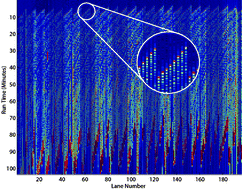A 768-lane DNA sequencing system based on microfluidic plates has been designed as a near-term successor to 96-lane capillary arrays. Electrophoretic separations are implemented for the first time in large-format (25 cm × 50 cm) microdevices, with the objective of proving realistic read length, parallelism, and the scaled sample requirements for long-read de novo sequencing. Two 384-lane plates are alternatively cycled between electrophoresis and regeneration via a robotic pipettor. A total of greater than 172 000 bases, 99% accuracy (corresponding to quality score 20) is achieved for each iteration of a 384 lane plate. At current operating conditions, this implies a system throughput exceeding 4 megabases of raw sequence (Phred 20) per day on the new platform. Standard operation is at “1/32×” Sanger chemistry, equal to typical genome center operation on mature capillary array machines, and a 16-fold improvement in scaling relative to previous microfabricated devices. Experiments provide evidence that sample concentration can be further reduced to 1/256× Sanger chemistry in the microdevice. Life-testing indicates a usable life of >150 hours (more than 50 runs) for the 384 lane plates. The combined advances, particularly those in read length and sample requirement, directly address the cost model requirements for adaptation of the new technology as the next step beyond capillary array instruments.

You have access to this article
 Please wait while we load your content...
Something went wrong. Try again?
Please wait while we load your content...
Something went wrong. Try again?


 Please wait while we load your content...
Please wait while we load your content...